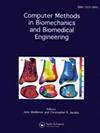基于拉索特征选择和机器学习的糖尿病患者骨折风险预测
IF 1.7
4区 医学
Q3 COMPUTER SCIENCE, INTERDISCIPLINARY APPLICATIONS
Computer Methods in Biomechanics and Biomedical Engineering
Pub Date : 2024-09-11
DOI:10.1080/10255842.2024.2400325
引用次数: 0
摘要
由于糖尿病与骨骼健康之间的多方面关系,糖尿病患者的骨折风险给临床带来了巨大挑战。糖尿病不仅会影响骨密度,还会改变骨质和结构,从而增加骨折的易感性。鉴于糖尿病及其相关并发症在全球的发病率不断上升,准确预测糖尿病患者的骨折风险已成为一项迫切的临床需求。本研究旨在调查影响糖尿病患者骨折风险的因素。我们提出了一个将 Lasso 特征选择与八种分类算法相结合的框架。首先,采用 Lasso 回归来选择 24 个重要特征。随后,我们利用网格搜索和 5 倍交叉验证来训练和调整所选的分类算法,包括 KNN、Naive Bayes、决策树、随机森林、AdaBoost、XGBoost、多层感知器(MLP)和支持向量机(SVM)。在使用这些重要特征训练的模型中,随机森林的性能最高,预测准确率达到 93.87%。对所有特征、重要特征和其余特征的比较分析表明,Lasso 回归所选择的特征在预测糖尿病患者骨折风险方面起着至关重要的作用。此外,通过使用特征重要性排序算法,我们还发现了几个对预测糖尿病患者早期骨折风险具有重要参考价值的特征。本文章由计算机程序翻译,如有差异,请以英文原文为准。
Fracture risk prediction in diabetes patients based on Lasso feature selection and Machine Learning.
Fracture risk among individuals with diabetes poses significant clinical challenges due to the multifaceted relationship between diabetes and bone health. Diabetes not only affects bone density but also alters bone quality and structure, thereby increases the susceptibility to fractures. Given the rising prevalence of diabetes worldwide and its associated complications, accurate prediction of fracture risk in diabetic individuals has emerged as a pressing clinical need. This study aims to investigate the factors influencing fracture risk among diabetic patients. We propose a framework that combines Lasso feature selection with eight classification algorithms. Initially, Lasso regression is employed to select 24 significant features. Subsequently, we utilize grid search and 5-fold cross-validation to train and tune the selected classification algorithms, including KNN, Naive Bayes, Decision Tree, Random Forest, AdaBoost, XGBoost, Multi-layer Perceptron (MLP), and Support Vector Machine (SVM). Among models trained using these important features, Random Forest exhibits the highest performance with a predictive accuracy of 93.87%. Comparative analysis across all features, important features, and remaining features demonstrate the crucial role of features selected by Lasso regression in predicting fracture risk among diabetic patients. Besides, by using a feature importance ranking algorithm, we find several features that hold significant reference values for predicting early bone fracture risk in diabetic individuals.
求助全文
通过发布文献求助,成功后即可免费获取论文全文。
去求助
来源期刊
CiteScore
4.10
自引率
6.20%
发文量
179
审稿时长
4-8 weeks
期刊介绍:
The primary aims of Computer Methods in Biomechanics and Biomedical Engineering are to provide a means of communicating the advances being made in the areas of biomechanics and biomedical engineering and to stimulate interest in the continually emerging computer based technologies which are being applied in these multidisciplinary subjects. Computer Methods in Biomechanics and Biomedical Engineering will also provide a focus for the importance of integrating the disciplines of engineering with medical technology and clinical expertise. Such integration will have a major impact on health care in the future.

 求助内容:
求助内容: 应助结果提醒方式:
应助结果提醒方式:


